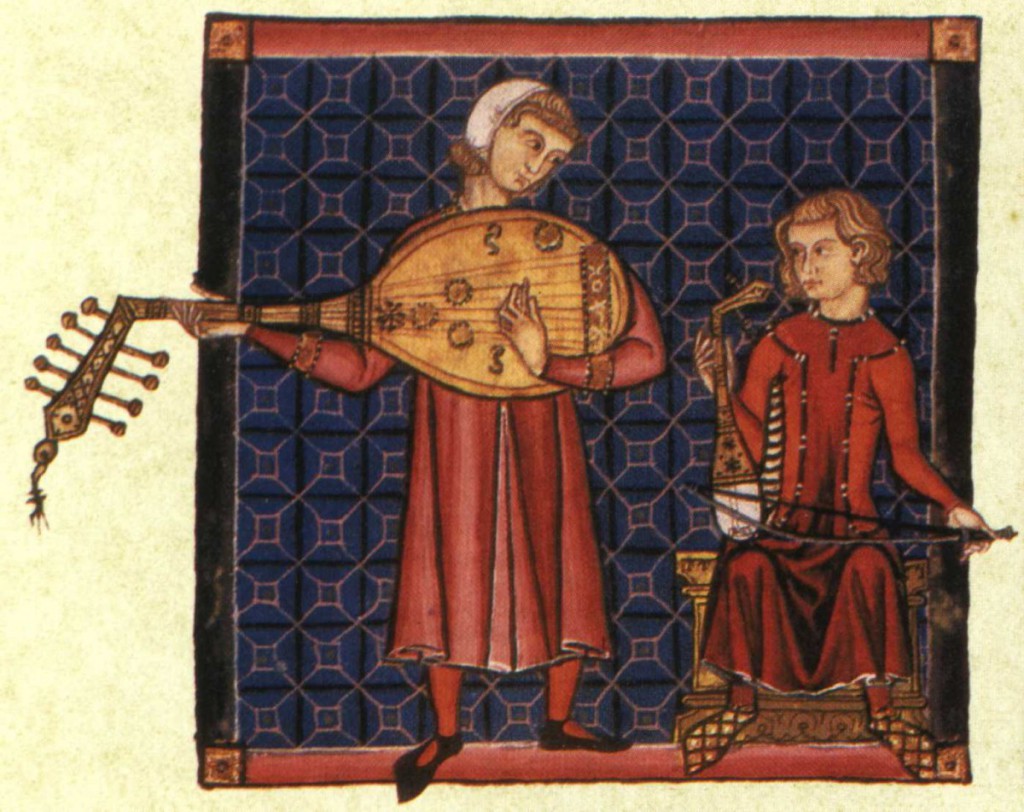 Cantiga 170. Cantigas de Santa María. Real Monasterio de S. Lorenzo de El Escorial, B.I.2. (códice de los músicos)
Cantiga 170. Cantigas de Santa María. Real Monasterio de S. Lorenzo de El Escorial, B.I.2. (códice de los músicos)
April 12 Works-in-the-Works talk by Dr. Christopher Swift (Humanities), reviewed by Dr. David Sánchez-Jiménez
SPANISH
Dr. Christopher Swift se adentró en el desconocido terreno de la representación artística de las más de 400 piezas musicales que contienen los cuatro Códices manuscritos de las Cantigas de Santa María en la luminosa obra del rey Alfonso X “El Sabio”, enmarcada en la oscura etapa de la Edad Media. Las Cantigas están escritas en galaico-portugués, una lengua hablada en Castilla en aquel tiempo y la mayoría de ellas cuentan los milagros sucedidos con la intervención de la Virgen María. A pesar de no contar con más documentos ni testimonios de esta representación más que con su propio conocimiento sobre el objeto de estudio y de la época en cuestión, el Dr. Swift presentó evidencias de una posible representación musical de las cantigas, ofreciendo al público asistente una serie de razonadas hipótesis basadas en las miniaturas y en los escritos del Códice.
Tras esta breve y precisa introducción, a continuación Christopher hizo una descripción de los cuatro códices de las Cantigas (códice de Toledo, códice de la Biblioteca de El Escorial, códice de Florencia y códice de los músicos). Swift comentó que el manuscrito recoge canciones genéricas de la época y otras originales compuestas por Alfonso X, aunque la discusión es perenne en cuanto a la autoría de las unas y las otras. Lo que parece quedar claro en el estudio de las miniaturas mostradas por el ponente es que se solían tomar algunas de las anotaciones recogidas en las cantigas mientras se improvisaban los temas musicales en la corte, la presencia de trovadores en la misma o de escenas musicales dentro de una iglesia -más evidentes en el Libro de Devociones-, así como la presencia de una representación teatralizada sugerida por el hallazgo de una escultura de la virgen con movimiento perteneciente a esta época.
Dr. Swift concluyó su presentación afirmando con rotundidad y acierto que las Cantigas no fueron creadas para permanecer escritas y formar parte de un museo, sino que eran la base de las representaciones realizadas en la comunidad cristiana, las cuales narraban las crónicas de la época con fines propagandísticos con el fin de agrandar la importancia de su figura y de expandir la trascendencia de sus logros en el campo de batalla y en el de las artes.
ENGLISH
Dr. Christopher Swift delved into the territory of the artistic representation of more than 400 musical pieces included in the four manuscripts known as Cantigas de Santa María or Songs of Holy Mary, which belong to the illuminated work of King Alfonso X “El Sabio” (the Wise) during the Middle Ages. The Cantigas are written in Galician-Portuguese, a language spoken in that period, and most of these songs refer to the Marian miracles. Relying on his deep knowledge and research on the said period, Dr. Swift discussed the musical representations of musical performance in the Cantigas, which provided the audience a series of substantiated observations based on the examples of the illuminations and textual pieces contained in the manuscript.
After the brief introduction, Dr. Swift made a description of the four codices of the Cantigas – the codex of Toledo, codex of El Escorial Library, codex of Florence and the codex of the musicians. Dr. Swift discussed that the manuscript contained some generic songs of that time, mixed with the original compositions of King Alfonso X. However, the subject on the authorship of the Cantigas is still heavily discussed. What proves to be clear though in the study of the illuminations showed by the speaker is that these were depictions on how they would take notes in the scrolls while improvising musical pieces in the Court, the existence of troubadours and other musical performances which would take place in the church – mostly evident in the Libro de Devociones – as well as the existence of a theatrical representation suggested by the discovery of a moving sculpture of the Holy Virgin belonging to this period.
Dr. Swift concluded his lecture by stating that the Cantigas were not created to remain neither as a written work of art nor as a piece in a museum exhibit, but to be the base of representations within the Christian community. These pieces chronicled the period with propaganda objectives in order to show the accomplishment of King Alfonso X during the war and in the arts.



